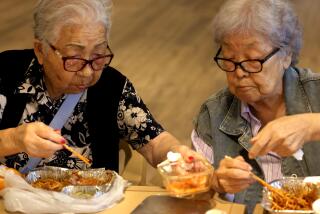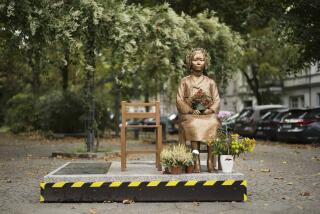Backers of Little Tokyo Gym Decry Museum Plan
- Share via
Shaken by the city’s decision to let the Children’s Museum build its new downtown campus in Little Tokyo, backers of a community gymnasium are urging city and museum officials to approve a new site for their project.
Having a gym in Little Tokyo for basketball, volleyball, martial arts and other community activities has been a dream of Japanese Americans in Southern California for a quarter century.
Five years ago, a group organized by community leader Bill Watanabe proposed building the gym along Temple Street near Alameda Street but was told by Councilwoman Rita Walters to look elsewhere because the city planned to use the area for green space. Walters has said she wants a gym in Little Tokyo but not at that location.
“I don’t see that the Children’s Museum represents grass and trees,” Watanabe said Monday.
Walters, however, said she approved the Children’s Museum on the site because it would be an “excellent fit” with museums, restaurants and other structures east of downtown.
All that has left Watanabe and his group baffled and frustrated.
“As of today, there is no other site available,” said Watanabe, executive director of the Little Tokyo Service Center.
Watanabe appealed Monday to a meeting of the Central Avenue Art Park Steering Committee, held at the Japanese American National Museum.
“We would like to ask that the gym must be accommodated at this site,” Watanabe told the committee. “We want your support. It’s not enough to say that you don’t oppose it.”
The space the group wants is at the southeast corner of Temple and Judge John Aiso (formerly San Pedro) streets, just south of the Children’s Museum site. Along with historic shops on 1st Street, major occupants of the block include the Japanese American National Museum, the Museum of Contemporary Art’s Geffen Contemporary building and the Union Center for the Arts.
The Little Tokyo Community Gymnasium Group has sought to acquire several sites and has raised about $1 million toward that end. If they get the city-owned property in the same block as the museums, it would cost $1 a year to lease.
The Children’s Museum has received two 50-year leases, one for about 1 acre at a corner of Temple and Alameda, and a site at Hansen Dam in the San Fernando Valley, said Doug Ring, president of the Children’s Museum board.
Speaking in his private capacity, Ring said in an interview that he has promised Watanabe that he would lend his “personal assistance” to the idea of having both the museum and the gym at the same site.
But Walters, whose district includes Little Tokyo, said her mind is made up. She wants to retain a space for a green area in the Little Tokyo block. Instead of the gym, she wants the garage at the contested site to be redeveloped as an underground parking structure, leaving room for grass and trees above.
Having that open space would provide a nice ambience for shoppers, museum-goers and restaurant patrons, she said. “We hope that the businesses on 1st Street will open their rear doors and begin serving outside so we can put tables outdoors,” she said in an interview. “It could be a just a very nice venue.”
Still, Walters said her first preference would have been to make the whole area park-like, with a Japanese garden and a plaza where outdoor concerts and performances could be held.
Darrell Daniel, a longtime apartment resident of the block, accused Walters of being a hypocrite.
“For four years we went looking [for a gym site] in good faith because she said she wanted green space,” Daniel said. “The next thing we learn . . . is that she has approved the Children’s Museum. That’s what we’re upset about. It’s all politics.”
Anthony K. Sperl, a property owner on 1st Street and a gym backer, called Walter’s plan ill-advised. A gymnasium would bring people and money to Little Tokyo but a large open space will be a magnet for transients, he said.
At Monday’s meeting, gym supporters urged the executive directors of the Japanese American National Museum and the Museum of Contemporary Art to give a favorable recommendation and help persuade Walters to change her mind.
Under a “joint powers” agreement, the executive directors of the two museums are authorized to make all major decisions on developing, designing and building of the proposed Central Avenue Art Park, a project spearheaded by Walters.
Neither Randall O. Murphy, representing MOCA nor Irene Hirano, executive director of the Japanese American National Museum gave any indication of how they stand.
Speaking for her museum and MOCA, Hirano said “different points of view” will be heard. But ultimately, she said, the decision on the gym would be the city’s.
In an interview last week, Hirano said she didn’t oppose the gym at the site. Asked if she supported it, she said she had “an open mind,” adding that the process needs to take its course.
Dean Toji, president of the Little Tokyo Service Center Community Development Corp. and numerous other gym supporters believe the Museum of Contemporary Art, with its considerable political clout, doesn’t want the gym there.
“They have their own plans for what they want down here,” said Toji, who teaches Asian American studies at Cal State at Long Beach. “It’s just a land grab on their part. They got a temporary space that became permanent [the Geffen Contemporary]. They started to see everything else as theirs.”
MOCA officials referred all questions to Hirano, citing the joint powers agreement that divides the two organizations’ tasks.
Though public disagreements are rare in the Japanese American community, old friends are finding themselves on the opposite sides on the gym project.
“It’s highly imprudent to make a public case out of it at this time,” said actor George Takei, chairman of the of the Japanese American National Museum Board.
Takei, who is also affiliated with East West Players, says he supports a gym in Little Tokyo, but not next door to the theater because of noise.
What could be more noisy than outdoor performances? asked Watanabe.
To Brian Kito, owner of Fugetsu-do confectionary and a member of the Little Tokyo Public Safety group, noise is not an “issue.” Any group that uses the area is bound to make noise, he said.
Watanabe said the gym would be designed to take noise and other factors into consideration.
“We tried to be nice, accommodating people and where has it gotten us? Nowhere,” Watanabe said. “At the same time these people are proceeding on the block as if we don’t exist. Now they’re telling us, ‘We don’t know if we have enough room for you.’ We are saying, ‘You can’t tell us there is no room for us. Who invited you?’ ”
For decades, Japanese Americans have talked about building a multipurpose gym in Little Tokyo. Yet, despite grass-roots support, the proposal has had numerous setbacks.
One gym had been planned for the $14-million Japanese American Cultural and Community Center complex, which was completed in 1983. But it was discarded when sculptor Isamu Noguchi insisted on using the entire one-acre site as an open plaza for his work.
(BEGIN TEXT OF INFOBOX / INFOGRAPHIC)
Scene of Controversy
Japanese American proponents of a gym for Little Tokyo have their eyes on a site that is now a three-story parking garage at Temple and Judge John Aiso streets. Councilwoman Rita Waters wants to see the property developed as an underground garage with green space at street level.
*
More to Read
The biggest entertainment stories
Get our big stories about Hollywood, film, television, music, arts, culture and more right in your inbox as soon as they publish.
You may occasionally receive promotional content from the Los Angeles Times.










